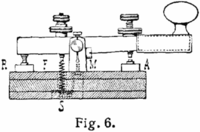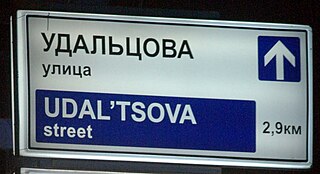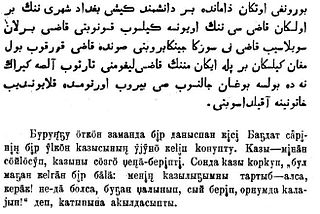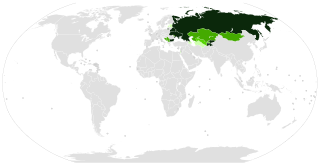
This is a summary of the use of Morse code to represent alphabets other than Latin.

This is a summary of the use of Morse code to represent alphabets other than Latin.
The Greek Morse code alphabet is very "similar" to the Latin alphabet. The "similarity" is based first on optical resemblance of each letter, a.k.a glyph, and then secondly on sound. Example, A both in Greek and English is the same glyph and sound (like a in word apple). The Greek B though, is identical to the English B as far as the glyph is concerned, even though the sound of Greek B is the same as the sound of English V (like the v in word victory). The B prevails to V. The Greek Morse code alphabet uses one extra letter for Greek letter Χ and no longer uses the codes for Latin letters "J", "U" and "V".
| Greek | Code | ITU | Greek | Code | ITU | Greek | Code | ITU | ||
|---|---|---|---|---|---|---|---|---|---|---|
| Α | ▄ ▄▄▄ | A | Ι | ▄ ▄ | I | Ρ | ▄ ▄▄▄ ▄ | R | ||
| Β | ▄▄▄ ▄ ▄ ▄ | B | Κ | ▄▄▄ ▄ ▄▄▄ | K | Σ | ▄ ▄ ▄ | S | ||
| Γ | ▄▄▄ ▄▄▄ ▄ | G | Λ | ▄ ▄▄▄ ▄ ▄ | L | Τ | ▄▄▄ | T | ||
| Δ | ▄▄▄ ▄ ▄ | D | Μ | ▄▄▄ ▄▄▄ | M | Υ | ▄▄▄ ▄ ▄▄▄ ▄▄▄ | Y | ||
| Ε | ▄ | E | Ν | ▄▄▄ ▄ | N | Φ | ▄ ▄ ▄▄▄ ▄ | F | ||
| Ζ | ▄▄▄ ▄▄▄ ▄ ▄ | Z | Ξ | ▄▄▄ ▄ ▄ ▄▄▄ | X | Χ | ▄▄▄ ▄▄▄ ▄▄▄ ▄▄▄ | CH | ||
| Η | ▄ ▄ ▄ ▄ | H | Ο | ▄▄▄ ▄▄▄ ▄▄▄ | O | Ψ | ▄▄▄ ▄▄▄ ▄ ▄▄▄ | Q | ||
| Θ | ▄▄▄ ▄ ▄▄▄ ▄ | C | Π | ▄ ▄▄▄ ▄▄▄ ▄ | P | Ω | ▄ ▄▄▄ ▄▄▄ | W | ||
| Diphthongs (obsolete) | ||||||||||
| HY | ▄ ▄ ▄ ▄▄▄ | V | YI | ▄ ▄▄▄ ▄▄▄ ▄▄▄ | J | OY | ▄ ▄ ▄▄▄ | U | ||
| OI | ▄▄▄ ▄▄▄ ▄▄▄ ▄ ▄ | 8 | EI | ▄ ▄ ▄ | S | AI | ▄ ▄▄▄ ▄ ▄▄▄ | Ä | ||
| AY | ▄ ▄ ▄▄▄ ▄▄▄ | Ü | EY | ▄▄▄ ▄▄▄ ▄▄▄ ▄ | Ö | |||||
The tonos is not transmitted in Morse code; the receiver can simply infer which vowels require one. The Greek diphthongs presented in the bottom three rows of the table are specified in old Greek Morse-code tables but they are never used in actual communication, the two vowels being sent separately.
Cyrillic letters are represented using the representation of similar-sounding Latin letters (e.g. Б ⇒ B, В ⇒ W [German pronunciation], Г ⇒ G, Д ⇒ D, etc.). Cyrillic letters with no such Latin correspondence are assigned to Latin letters with no Cyrillic correspondence (e.g. Щ⇒Q). The same correspondence was later used to create Russian national character sets KOI-7 and KOI-8.
| Cyrillic | Code | ITU | Cyrillic | Code | ITU | Cyrillic | Code | ITU | Cyrillic | Code | ITU | |||
|---|---|---|---|---|---|---|---|---|---|---|---|---|---|---|
| А | ▄ ▄▄▄ | A | И(Ukr. І) | ▄ ▄ | I | Р | ▄ ▄▄▄ ▄ | R | Ш | ▄▄▄ ▄▄▄ ▄▄▄ ▄▄▄ | (CH) | |||
| Б | ▄▄▄ ▄ ▄ ▄ | B | Й | ▄ ▄▄▄ ▄▄▄ ▄▄▄ | J | С | ▄ ▄ ▄ | S | Щ | ▄▄▄ ▄▄▄ ▄ ▄▄▄ | Q | |||
| В | ▄ ▄▄▄ ▄▄▄ | W | К | ▄▄▄ ▄ ▄▄▄ | K | Т | ▄▄▄ | T | Ь(Bul. Ъ) | ▄▄▄ ▄ ▄ ▄▄▄ | X | |||
| Г | ▄▄▄ ▄▄▄ ▄ | G | Л | ▄ ▄▄▄ ▄ ▄ | L | У | ▄ ▄ ▄▄▄ | U | Ы(Bul. Ь) | ▄▄▄ ▄ ▄▄▄ ▄▄▄ | Y | |||
| Д | ▄▄▄ ▄ ▄ | D | М | ▄▄▄ ▄▄▄ | M | Ф | ▄ ▄ ▄▄▄ ▄ | F | Э(Ukr. Є) | ▄ ▄ ▄▄▄ ▄ ▄ | É | |||
| Е | ▄ | E | Н | ▄▄▄ ▄ | N | Х | ▄ ▄ ▄ ▄ | H | Ю | ▄ ▄ ▄▄▄ ▄▄▄ | (Ü) | |||
| Ж | ▄ ▄ ▄ ▄▄▄ | V | О | ▄▄▄ ▄▄▄ ▄▄▄ | O | Ц | ▄▄▄ ▄ ▄▄▄ ▄ | C | Я | ▄ ▄▄▄ ▄ ▄▄▄ | (Ä) | |||
| З | ▄▄▄ ▄▄▄ ▄ ▄ | Z | П | ▄ ▄▄▄ ▄▄▄ ▄ | P | Ч | ▄▄▄ ▄▄▄ ▄▄▄ ▄ | (Ö) | Ї | ▄ ▄▄▄ ▄▄▄ ▄▄▄ ▄ | — |
The order and encoding shown uses the Russian national standard. The Bulgarian standard is the same except for the two letters (Ь, Ъ) given in parentheses: The Bulgarian language does not use Ы, while Ъ is frequent, but missing in Russian standard Morse.
The letter Ё (Yo) does not have an international Morse phonetic equivalent, with international Е used instead. Ukrainian Morse uses Є instead of Э, І instead of И, but also has И encoded as Ы, and has additional Ї (Yi).
Hebrew letters are mostly represented using the Morse representation of a similar-sounding Latin letter (e.g. "Bet" ב≡B); however the representation for several letters are from a Latin letter with a similar shape (e.g. "Tet" ט ≡U, while "Tav" ת≡T). Though Hebrew Morse code is transcribed from right to left, the table below is transcribed from left to right as per the Latin letters in the table.
| Letter | Code | ITU | Letter | Code | ITU | |
|---|---|---|---|---|---|---|
| א | ▄ ▄▄▄ | A | ל | ▄ ▄▄▄ ▄ ▄ | L | |
| ב | ▄▄▄ ▄ ▄ ▄ | B | מ | ▄▄▄ ▄▄▄ | M | |
| ג | ▄▄▄ ▄▄▄ ▄ | G | נ | ▄▄▄ ▄ | N | |
| ד | ▄▄▄ ▄ ▄ | D | ס | ▄▄▄ ▄ ▄▄▄ ▄ | C | |
| ה | ▄▄▄ ▄▄▄ ▄▄▄ | O | ע | ▄ ▄▄▄ ▄▄▄ ▄▄▄ | J | |
| ו | ▄ | E | פ | ▄ ▄▄▄ ▄▄▄ ▄ | P | |
| ז | ▄▄▄ ▄▄▄ ▄ ▄ | Z | צ | ▄ ▄▄▄ ▄▄▄ | W | |
| ח | ▄ ▄ ▄ ▄ | H | ק | ▄▄▄ ▄▄▄ ▄ ▄▄▄ | Q | |
| ט | ▄ ▄ ▄▄▄ | U | ר | ▄ ▄▄▄ ▄ | R | |
| י | ▄ ▄ | I | ש | ▄ ▄ ▄ | S | |
| כ | ▄▄▄ ▄ ▄▄▄ | K | ת | ▄▄▄ | T |
| Letter | Code | ITU | Letter | Code | ITU | Letter | Code | ITU | Letter | Code | ITU | |||
|---|---|---|---|---|---|---|---|---|---|---|---|---|---|---|
| ا | ▄ ▄▄▄ | A | ذ | ▄▄▄ ▄▄▄ ▄ ▄ | Z | ط | ▄ ▄ ▄▄▄ | U | ل | ▄ ▄▄▄ ▄ ▄ | L | |||
| ب | ▄▄▄ ▄ ▄ ▄ | B | ر | ▄ ▄▄▄ ▄ | R | ظ | ▄▄▄ ▄ ▄▄▄ ▄▄▄ | Y | م | ▄▄▄ ▄▄▄ | M | |||
| ت | ▄▄▄ | T | ز | ▄▄▄ ▄▄▄ ▄▄▄ ▄ | Ö | ع | ▄ ▄▄▄ ▄ ▄▄▄ | Ä | ن | ▄▄▄ ▄ | N | |||
| ث | ▄▄▄ ▄ ▄▄▄ ▄ | C | س | ▄ ▄ ▄ | S | غ | ▄▄▄ ▄▄▄ ▄ | G | ه | ▄ ▄ ▄▄▄ ▄ ▄ | É | |||
| ج | ▄ ▄▄▄ ▄▄▄ ▄▄▄ | J | ش | ▄▄▄ ▄▄▄ ▄▄▄ ▄▄▄ | CH | ف | ▄ ▄ ▄▄▄ ▄ | F | و | ▄ ▄▄▄ ▄▄▄ | W | |||
| ح | ▄ ▄ ▄ ▄ | H | ص | ▄▄▄ ▄ ▄ ▄▄▄ | X | ق | ▄▄▄ ▄▄▄ ▄ ▄▄▄ | Q | ي | ▄ ▄ | I | |||
| خ | ▄▄▄ ▄▄▄ ▄▄▄ | O | ض | ▄ ▄ ▄ ▄▄▄ | V | ك | ▄▄▄ ▄ ▄▄▄ | K | ﺀ | ▄ | E | |||
| د | ▄▄▄ ▄ ▄ | D | ||||||||||||
| Letter | In Latin | Code | Letter | In Latin | Code | Letter | In Latin | Code | Letter | In Latin | Code | Letter | In Latin | Code | ||||
|---|---|---|---|---|---|---|---|---|---|---|---|---|---|---|---|---|---|---|
| ا | A | ▄ ▄▄▄ | گ | G | ▄▄▄ ▄▄▄ ▄ | ڵ | Ł | ▄ ▄▄▄ ▄ ▄ ▄▄▄ | ڕ | Ř | ▄▄▄ ▄▄▄ ▄▄▄ ▄ ▄▄▄ | و | W | ▄ ▄▄▄ ▄▄▄ | ||||
| ب | B | ▄▄▄ ▄ ▄ ▄ | ھ | H | ▄ ▄ ▄ ▄ | م | M | ▄▄▄ ▄▄▄ | س | S | ▄ ▄ ▄ | خ | X | ▄▄▄ ▄ ▄ ▄▄▄ | ||||
| ج | C | ▄▄▄ ▄ ▄▄▄ ▄ | ح | Ḧ | ▄▄▄ ▄ ▄▄▄ ▄▄▄ ▄▄▄ | ن | N | ▄▄▄ ▄ | ش | Ş | ▄ ▄ ▄ ▄▄▄ ▄ | غ | Ẍ | ▄ ▄▄▄ ▄ ▄▄▄ ▄▄▄ | ||||
| چ | Ç | ▄▄▄ ▄ ▄▄▄ ▄ ▄ | - | I | ▄ ▄ | نٚ | Ň | ▄▄▄ ▄▄▄ ▄ ▄▄▄ ▄▄▄ | ت | T | ▄▄▄ | ی | Y | ▄▄▄ ▄ ▄▄▄ ▄▄▄ | ||||
| ڎ | Đ | ▄ ▄ ▄▄▄ ▄▄▄ ▄ | ی | Î | ▄ ▄▄▄ ▄▄▄ ▄▄▄ ▄ | ۆ | O | ▄▄▄ ▄▄▄ ▄▄▄ | و | U | ▄ ▄ ▄▄▄ | ز | Z | ▄▄▄ ▄▄▄ ▄ ▄ | ||||
| ە | E | ▄ | ژ | J | ▄ ▄▄▄ ▄▄▄ ▄▄▄ | پ | P | ▄ ▄▄▄ ▄▄▄ ▄ | وو | Û | ▄▄▄ ▄ ▄ ▄▄▄ ▄▄▄ | ع | ' | ▄ ▄ ▄▄▄ ▄ ▄▄▄ | ||||
| ێ | Ê | ▄ ▄ ▄▄▄ ▄ ▄ | ک | K | ▄▄▄ ▄ ▄▄▄ | ق | Q | ▄▄▄ ▄▄▄ ▄ ▄▄▄ | ۊ | Ü | ▄ ▄ ▄▄▄ ▄▄▄ | د | D | ▄▄▄ ▄ ▄ | ||||
| ف | F | ▄ ▄ ▄▄▄ ▄ | ل | L | ▄ ▄▄▄ ▄ ▄ | ر | R | ▄ ▄▄▄ ▄ | ڤ | V | ▄ ▄ ▄ ▄▄▄ |
See [1]
| Letter | Code | ITU | Letter | Code | ITU | Letter | Code | ITU | Letter | Code | ITU | |||
|---|---|---|---|---|---|---|---|---|---|---|---|---|---|---|
| ا | ▄ ▄▄▄ | A | خ | ▄▄▄ ▄ ▄ ▄▄▄ | X | ص | ▄ ▄▄▄ ▄ ▄▄▄ | Ä | ک | ▄▄▄ ▄ ▄▄▄ | K | |||
| ب | ▄▄▄ ▄ ▄ ▄ | B | د | ▄▄▄ ▄ ▄ | D | ض | ▄ ▄ ▄▄▄ ▄ ▄ | É | گ | ▄▄▄ ▄▄▄ ▄ ▄▄▄ | Q | |||
| پ | ▄ ▄▄▄ ▄▄▄ ▄ | P | ذ | ▄ ▄ ▄ ▄▄▄ | V | ط | ▄ ▄ ▄▄▄ | U | ل | ▄ ▄▄▄ ▄ ▄ | L | |||
| ت | ▄▄▄ | T | ر | ▄ ▄▄▄ ▄ | R | ظ | ▄▄▄ ▄ ▄▄▄ ▄▄▄ | Y | م | ▄▄▄ ▄▄▄ | M | |||
| ث | ▄▄▄ ▄ ▄▄▄ ▄ | C | ز | ▄▄▄ ▄▄▄ ▄ ▄ | Z | ع | ▄▄▄ ▄▄▄ ▄▄▄ | O | ن | ▄▄▄ ▄ | N | |||
| ج | ▄ ▄▄▄ ▄▄▄ ▄▄▄ | J | ژ | ▄▄▄ ▄▄▄ ▄ | G | غ | ▄ ▄ ▄▄▄ ▄▄▄ | Ü | و | ▄ ▄▄▄ ▄▄▄ | W | |||
| چ | ▄▄▄ ▄▄▄ ▄▄▄ ▄ | Ö | س | ▄ ▄ ▄ | S | ف | ▄ ▄ ▄▄▄ ▄ | F | ه | ▄ | E | |||
| ح | ▄ ▄ ▄ ▄ | H | ش | ▄▄▄ ▄▄▄ ▄▄▄ ▄▄▄ | CH | ق | ▄▄▄ ▄▄▄ ▄▄▄ ▄ ▄ ▄ | : | ی | ▄ ▄ | I |
See also fa:کد مورس
Devanagari is a left-to-right abugida (alphasyllabary) widely used in the Indian subcontinent. The following telegraph code table is adapted from one given by Ashok Kelkar, [2] where the Latin letters are encoded as per the International Morse code standard. Some variations on this code exist, [3] and there have been some attempts to introduce other telegraph codes either to improve efficiency or to apply to more Indian languages. [2] [4] [5] Proposals for a telegraph code suitable for multiple Indian languages have been made as early as 1948, shortly after independence. [6]
| Devanagari | Latin Morse | Devanagari | Latin Morse | Devanagari | Latin Morse | Devanagari | Latin Morse | |||
|---|---|---|---|---|---|---|---|---|---|---|
| ा | A | अ | TA | ः | EA | आ | IA | |||
| ि | D | इ | TD | ी | ED | ई | ID | |||
| ु | U | उ | TU | ू | EU | ऊ | IU | |||
| े | F | ए | TF | े | EF | ऐ | IF | |||
| ो | O | ओ | TO | ो | EO | औ | IO | |||
| क | K | क् | TK | ख | EK | ख् | IK | |||
| ग | G | ग् | TG | घ | EG | घ् | IG | |||
| च | C | च् | TC | छ | EC | छ् | IC | |||
| ज | J | ज् | TJ | झ | EJ | झ् | IJ | |||
| ट | Ä | ट् | TÄ | ठ | EÄ | ठ् | IÄ | |||
| ड | Ü | ड् | TÜ | ढ | EÜ | ढ् | IÜ | |||
| त | W | त् | TW | थ | EW | थ् | IW | |||
| द | Z | द् | TZ | ध | EZ | ध् | IZ | |||
| न | N | न् | TN | ं | EN | ँ | IN | |||
| प | P | प् | TP | फ | EP | फ् | IP | |||
| ब | B | ब् | TB | भ | EB | भ् | IB | |||
| म | M | म् | TM | ण | EM | ण् | IM | |||
| य | Y | य् | TY | ळ | EY | ळ् | IY | |||
| र | R | र् | TR | ER | क्र | IR | ||||
| ल | L | ल् | TL | ञ | EL | ञ् | IL | |||
| व | V | व् | TV | ङ | EV | ङ् | IV | |||
| स | S | स् | TS | श | ES | श् | IS | |||
| ह | H | ह् | TH | ष | EH | ष् | IH | |||
| ृ | Ö | ़ | TÖ | ॆ | EÖ | IÖ | ||||
| क्ष | Q | क्ष् | TQ | त्र | EQ | त्र् | IQ | |||
| ज्ञ | X | ज्ञ् | TX | श्र | EX | श्र् | IX | |||
| में | MM | है | TMM | मैं | EMM | हूँ | IMM |
See SKATS.
See Wabun code.
See รหัสมอร์ส on the Thai Wikipedia

The Cyrillic script, Slavonic script or simply Slavic script is a writing system used for various languages across Eurasia. It is the designated national script in various Slavic, Turkic, Mongolic, Uralic, Caucasian and Iranic-speaking countries in Southeastern Europe, Eastern Europe, the Caucasus, Central Asia, North Asia, and East Asia, and used by many other minority languages.

The Russian alphabet is the script used to write the Russian language. It comes from the Cyrillic script, which was devised in the 9th century for the first Slavic literary language, Old Slavonic. Initially an old variant of the Bulgarian alphabet, it became used in the Kievan Rusʹ since the 10th century to write what would become the modern Russian language.

The Romanian alphabet is a variant of the Latin alphabet used for writing the Romanian language. It is a modification of the classical Latin alphabet and consists of 31 letters, five of which have been modified from their Latin originals for the phonetic requirements of the language:

The Cyrillic I is a letter used in almost all Cyrillic alphabets with the exception of Belarusian.

The Bulgarian Cyrillic alphabet is used to write the Bulgarian language. The Cyrillic alphabet was originally developed in the First Bulgarian Empire during the 9th – 10th century AD at the Preslav Literary School.

The romanization of the Russian language, aside from its primary use for including Russian names and words in text written in a Latin alphabet, is also essential for computer users to input Russian text who either do not have a keyboard or word processor set up for inputting Cyrillic, or else are not capable of typing rapidly using a native Russian keyboard layout (JCUKEN). In the latter case, they would type using a system of transliteration fitted for their keyboard layout, such as for English QWERTY keyboards, and then use an automated tool to convert the text into Cyrillic.
KOI (КОИ) is a family of several code pages for the Cyrillic script. The name stands for Kod obmena informatsiey which means "Code for Information Interchange".

Yeru or Eru, usually called Y in modern Russian or Yery or Ery historically and in modern Church Slavonic, is a letter in the Cyrillic script. It represents the close central unrounded vowel after non-palatalised (hard) consonants in the Belarusian and Russian alphabets, and after any consonant in most of Rusyn standards, where it represents the unrounded close-mid back unrounded vowel sound.

The Ukrainian alphabet is the set of letters used to write Ukrainian, which is the official language of Ukraine. It is one of several national variations of the Cyrillic script. It comes from the Cyrillic script, which was devised in the 9th century for the first Slavic literary language, called Old Slavonic. In the 10th century, it became used in Kievan Rus' to write Old East Slavic, from which the Belarusian, Russian, Rusyn, and Ukrainian alphabets later evolved. The modern Ukrainian alphabet has 33 letters in total: 21 consonants, 1 semivowel, 10 vowels and 1 palatalization sign. Sometimes the apostrophe (') is also included, which has a phonetic meaning and is a mandatory sign in writing, but is not considered as a letter and is not included in the alphabet.

The letter Ъ ъ of the Cyrillic script is known as er goläm in the Bulgarian alphabet, as the hard sign in the modern Russian and Rusyn alphabets, as the debelo jer in pre-reform Serbian orthography, and as ayirish belgisi in the Uzbek Cyrillic alphabet. The letter is called back yer or back jer and yor or jor in the pre-reform Russian orthography, in Old East Slavic, and in Old Church Slavonic.
Unicode has subscripted and superscripted versions of a number of characters including a full set of Arabic numerals. These characters allow any polynomial, chemical and certain other equations to be represented in plain text without using any form of markup like HTML or TeX.
Unicode has a certain amount of duplication of characters. These are pairs of single Unicode code points that are canonically equivalent. The reason for this are compatibility issues with legacy systems.

Three alphabets are used to write Kazakh: the Cyrillic, Latin and Arabic scripts. The Cyrillic script is used in Kazakhstan and Mongolia. An October 2017 Presidential Decree in Kazakhstan ordered that the transition from Cyrillic to a Latin script be completed by 2031. The Arabic script is used in Saudi Arabia, Iran, Afghanistan, and parts of China.

The Serbian Cyrillic alphabet is a variation of the Cyrillic script used to write the Serbian language, updated in 1818 by the Serbian philologist and linguist Vuk Karadžić. It is one of the two alphabets used to write modern standard Serbian, the other being Gaj's Latin alphabet.

Numerous Cyrillic alphabets are based on the Cyrillic script. The early Cyrillic alphabet was developed in the 9th century AD and replaced the earlier Glagolitic script developed by the theologians Cyril and Methodius. It is the basis of alphabets used in various languages, past and present, Slavic origin, and non-Slavic languages influenced by Russian. As of 2011, around 252 million people in Eurasia use it as the official alphabet for their national languages. About half of them are in Russia. Cyrillic is one of the most-used writing systems in the world. The creator is Saint Clement of Ohrid from the Preslav literary school in the First Bulgarian Empire.
JCUKEN is the main Cyrillic keyboard layout for the Russian language in computers and typewriters. Earlier in Russia JIUKEN (ЙІУКЕН) layout was the main layout, but it was replaced by JCUKEN when the Russian alphabet reform of 1917 removed the letters Ѣ, І, Ѵ, and Ѳ. The letter Ъ had decreased in usage significantly after the reform.
The ISO basic Latin alphabet is an international standard for a Latin-script alphabet that consists of two sets of 26 letters, codified in various national and international standards and used widely in international communication. They are the same letters that comprise the current English alphabet. Since medieval times, they are also the same letters of the modern Latin alphabet. The order is also important for sorting words into alphabetical order.

Latin yeru or I with bowl is an additional letter of the Latin alphabet based on the Cyrillic soft sign. It was introduced in 1928 into the reformed Yañalif, and later into other alphabets for Soviet minority languages. The letter was designed specifically to represent the non-front close vowel sounds IPA:[ɨ] and IPA:[ɯ]. Thus, this letter corresponds to the letter ⟨I ı⟩ in modern Turkic alphabets, and the letter yery in Cyrillic.
The Komi language, a Uralic language spoken in the north-eastern part of European Russia, has been written in several different alphabets. Currently, Komi writing uses letters from the Cyrillic script. There have been five distinct stages in the history of Komi writing: